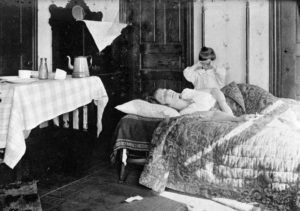 100 years ago today, October 20, 1918, my uncle died as part of the infamous 1918 Flu Pandemic. David Arthur Snelling contracted the flu, as did his mother, Gertrude Snelling. David, the fourth child of Arthur and Gertrude, died on this day at just 14 months old. Fortunately, his father and siblings did not come down with the disease. Older brother James had just turned eight, six days earlier on October 14th. Sister Elsie would celebrate her sixth birthday two days later on the 22nd. My mother, Ruth was three years old. David’s funeral was postponed while they waited to see if Gertrude was going to survive, which she did and went on to have four more children.
100 years ago today, October 20, 1918, my uncle died as part of the infamous 1918 Flu Pandemic. David Arthur Snelling contracted the flu, as did his mother, Gertrude Snelling. David, the fourth child of Arthur and Gertrude, died on this day at just 14 months old. Fortunately, his father and siblings did not come down with the disease. Older brother James had just turned eight, six days earlier on October 14th. Sister Elsie would celebrate her sixth birthday two days later on the 22nd. My mother, Ruth was three years old. David’s funeral was postponed while they waited to see if Gertrude was going to survive, which she did and went on to have four more children.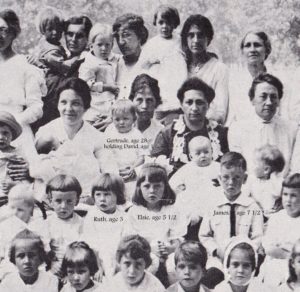
This photo of Gertrude and children was taken July 1918, three months before David’s death. The occasion was a celebration of the 500 mothers and children attended to by Zion’s Midwife, Ellen Lloyd.
The first reported cases, in Haskell County, Kansas, were thought to have begun in birds and hogs. The United States had entered into World War I in 1917. Men were being sent to nearby Camp Funston and within two weeks, thousands of soldiers became sick. Transferring soldiers soon infected 24 of the 36 U.S. Army camps, where tens of thousands contracted the flu. As soldiers were sent overseas, they carried the disease to Europe. Meanwhile, the flu began to spread to the civilian population. Some victims died within days or hours, as their skin turned blue and their lungs filled with fluid causing them to suffocate. Many public places such as schools, churches and theaters were shut down as the disease spread. Auditoriums, schools and other buildings were used as make-shift hospitals, some being staffed by medical students. Several communities imposed quarantines or required the wearing of masks.
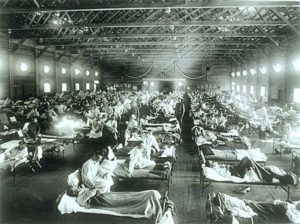
World War I soldiers at Camp Funston, KS ill with flu
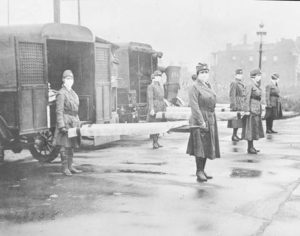
St. Louis, MO Red Cross workers
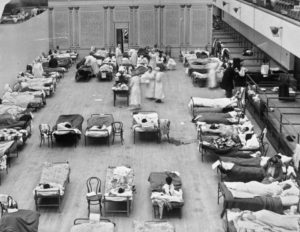
Temporary hospital in Oakland, CA
500 million people were infected world-wide with between 50 to 100 million deaths, making this the deadliest plague in history. 675,000 of those who died were from the USA. The disease affected 40% of the US Navy and 36% of the US Army. The troop were hit the hardest because the soldiers were weak, malnourished and kept moving around the world in crowded ships and trains, often in very unsanitary conditions. Now, 100 years later and the world still struggles with the flu, which has killed 80,000 people so far this year.